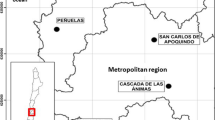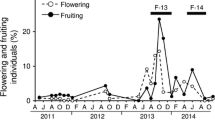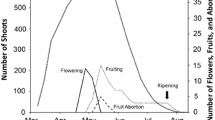Abstract
Absolute number of seeds lost to predispersal seed predators and proportion of total seeds lost per infructescence were compared among five Costa Rican Piper species of different annual fecundities. Mean seed number and mean seed size in the five species were negatively correlated. The impact of predation on these species was inversely related to the number of seeds they produced. The two early successional species had very high fecundities, a combination of many seeds per infructescence, many infructescences per plant, and, in one species, year-round reproduction. Although seed predators destroyed as many or more seeds of these early successional species than they did of the less fecund, late successional species, this loss accounted for a relatively minor proportion (9 and 12%) of the seeds of the early successional species. In contrast, late successional species produced fewer, larger seeds in a smaller number of infructescences and were not continually in fruit. One of these species, which produced intermediate numbers of intermediately sized seeds, lost 30% of the seeds in each infructescence on average. Seed predators destroyed a larger proportion (65 and 76%) of the seeds per infructescence in the two species with fewest seeds per infructescence. High levels of insect damage in these late successional species caused many of their infructescences to abort prematurely. Taken together these factors resulted in annual fecundities several orders of magnitude smaller in shade-tolerant Piper species than the annual fecundities of shade-intolerant, early successional species. Seedlings of the two early successional species were common in large gaps and other sunny clearings and seedlings of the species with 30% seed loss were occasional, whereas no seedlings were seen of the two species with the highest proportional seed loss, suggesting that seed predation on the latter species may limit seedling recruitment.
Similar content being viewed by others

References
Andersen AN (1988) Insect seed predators may cause far greater damage than they appear to. Oikos 53:337–340
Andersen AN (1989a) Pre-dispersal seed losses to insects in species of Leptospermum (Myrtaceae). Aust J Ecol 14:13–18
Andersen AN (1989b) How important is seed predation to recruitment in stable populations of long-lived perennials? Oecologia 81:310–315
Augspurger CK (1981) Reproductive synchrony of a tropical shrub: experimental studies on effects of pollinators and seed predators on Hybanthus prunifolius (Violaceae). Ecology 62:775–788
Auld TD (1983) Seed predation in native legumes of south-eastern Australia. Aust J Ecol 8:367–376
Auld TD (1986) Variation in predispersal seed predation in several Australian Acacia spp. Oikos 47:319–326
Bertness MD, Wise C, Ellison AM (1987) Consumer pressure and seed set in a salt marsh perennial plant community. Oecologia 71:190–200
Bohart GE, Koerber TW (1972) Insects and seed production. In: Kozlowski TT (ed) Seed biology. Academic Press, New York, pp 1–53
Bradford DF, Smith CC (1977) Seed predation and seed number of Scheelea palm fruits. Ecology 58:667–673
Burger W (1971) Piperaceae. Fieldiana Bot 35:5–227
Cavers PB (1983) Seed demography. Can J Bot 61:3578–3590
Crawley MJ (1987) Herbivores and plant population dynamics. In: Davy AJ, Hutchings MJ, Watkinson AR (eds) Plant population ecology. The 28th Symposium of the British Ecological Society. Blackwell Scientific Publications, Oxford, pp 367–392
Cronquist A (1981) An integrated system of classification of flowering plants. Columbia University Press, New York
De Steven D (1982) Seed production and seed mortality in a temperate forest shrub (witch-hazel), Hamamelis virginiana. J Ecol 70:437–443
De Steven D (1983) Reproductive consequences of insect seed predation in Hamamelis virginiana. Ecology 64:89–98
Ernst WHO, Tolsma DJ, Decelle JE (1989) Predation of seeds of Acacia tortilis by insects. Oecologia 54:294–300
Fleming TH (1985) Coexistence of five sympatric Piper (Piperaceae) species in a tropical dry forest. Ecology 66:688–700
Foster SA (1986) On the adaptive value of large seeds for tropical moist forest trees: a review and synthesis. Bot Rev 52:261–299
Gartner B (1989) Breakage and regrowth of Piper species in rain forest understory. Biotropica 21:303–307
Green TW, Palmbald IG (1975) Effects of insect seed predators on Astragalus cibarius and Astragalus utahensis (Leguminosae). Ecology 56:1435–1440
Greig N (1991) Ecology of co-occuring species of neotropical Piper: distribution, reproductive biology, and seed predation. PhD dissertation, University of Texas, Austin, TX
Harper JL (1977) The population biology of plants. Academic Press, New York
Hartshorn GS (1983) La Selva. In: Janzen DH (ed) Costa Rican natural history, University of Chicago Press, Chicago, IL, pp 136–141
Hickman JC (1979) The basic biology of plant numbers. In: Solbrig OT, Jain S, Johnson GB, Raven PH (eds) Topics in plant population biology. Columbia University Press, New York, pp 232–263
Janzen DH (1969) Seed-eaters versus seed size, number, toxicity and dispersal. Evolution 23:1–27
Janzen DH (1971) Seed predation by animals. Annu Rev Ecol Syst 2:465–492
Janzen DH (1975) Intra-and interhabitat variations in Guazuma ulmifolia (Sterculiaceae) seed predation by Amblycerus cistelinus (bruchidae) in Costa Rica. Ecology 56:1009–1013
Janzen DH (1976) Two patterns of pre-dispersal seed predation by insects on Central American deciduous forest trees. In: Burley J, Styles BT (eds) Tropical trees: variation, breeding, and conservation. Academic Press, New York, pp 179–188
Klinkhamer PGL, De Jong TJ, Van der Meijden E (1988) Production, dispersal and predation of seeds in the biennial Cirsium vulgare. J Ecol 76:403–414
Loiselle BS (1990) Seeds in droppings of tropical fruit-eating birds: importance of considering seed composition. Oecologia 82:494–500
Louda SM (1982a) Limitation of the recruitment of the shrub Haplopappus squarrosus (Asteraceae) by flower-and seed-feeding insects. J Ecol 70:43–53
Louda SM (1982b) Distribution ecology: variation in plant recruitment over a gradient in relation to insect seed predation. Ecol Monogr 52:25–41
Louda SM (1983) Seed predation and seedling mortality in the recruitment of a shrub, Haplopappus venetus (Asteraceae), along a climatic gradient. Ecology 64:511–521
Louda SM, Keeler KH, Holt RD (1990) Herbivore influences on plant performance and competitive interactions. In: Grace JB, Tilman D (eds) Perspectives in plant competition. Academic Press, New York, pp 413–444
Manley GV, Butcher JW, Cantlon JE (1975) Relationship of insects to distribution and abundance of Melampyrum lineare (Scrophulariaceae). Pedobiologia 15:385–404
Marquis RJ (1988) Phenological variation in the neotropical understory shrub Piper arieianum: causes and consequences. Ecology 69:1552–1565
Marquis RJ (1991) Herbivore fauna of Piper (Piperaceae) in a Costa Rican wet forest: diversity, specificity, and impact. In: Price PW, Lewinsohn TM, Fernandes GW, and Benson WW (eds) Plant-animal interactions: evolutionary ecology in tropical and temperate regions. John Wiley & Sons, New York, pp 179–207
Moore LR (1978) Seed predation in the legume Crotalaria. I. Intensity and variability of seed predation in native and introduced populations of C. pallida Ait. Oecologia 34:185–202
Orozco-Segovia A, Vázquez-Yanes C (1989) Light effect on seed germination in Piper L. Oecol Plant 10:123–146
Palmeirim JM, Gorchov DL, Stoleson S (1989) Trophic structure of a neotropical frugivore community: is there competition between birds and bats? Oecologia 79:403–411
Primack RB (1987) Relationships among flowers, fruits, and seeds. Annu Rev Ecol Syst 18:409–430
Salisbury EJ (1942) The reproductive capacity of plants. G. Bell and Sons Ltd, London
Scott JK (1982) The impact of destructive insects on reproduction in six species of Banskia L.f. (Proteaceae). Aust J Zool 30:901–921
Silvertown JW (1980) The evolutionary ecology of mast seeding in trees. Biol J Linn Soc 14:235–250
Vázquez-Yanes C (1976) Estudios sobre ecofisiología de la germinación en una zona calido-húmeda de México. In: Gomez-Pompa A, Vázquez-Yanes C, Del Amo S, Butanda A (eds) Regeneración de selvas. Ed. Continental, Mexico, pp 279–387
Waller DA (1989) Plant morphology and reproduction. In: Lovett-Doust J, Lovett-Doust L (eds) Plant reproductive ecology. Oxford University Press, Oxford, pp 203–227
Wilbur HM (1976) life history evolution in seven milkweeds of the genus Asclepias. J Ecol 64:223–240
Author information
Authors and Affiliations
Rights and permissions
About this article
Cite this article
Greig, N. Predispersal seed predation on five Piper species in tropical rainforest. Oecologia 93, 412–420 (1993). https://doi.org/10.1007/BF00317886
Received:
Accepted:
Issue Date:
DOI: https://doi.org/10.1007/BF00317886



